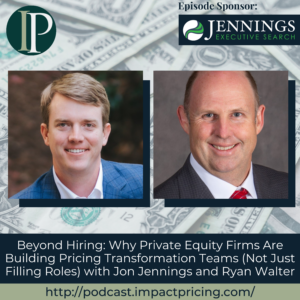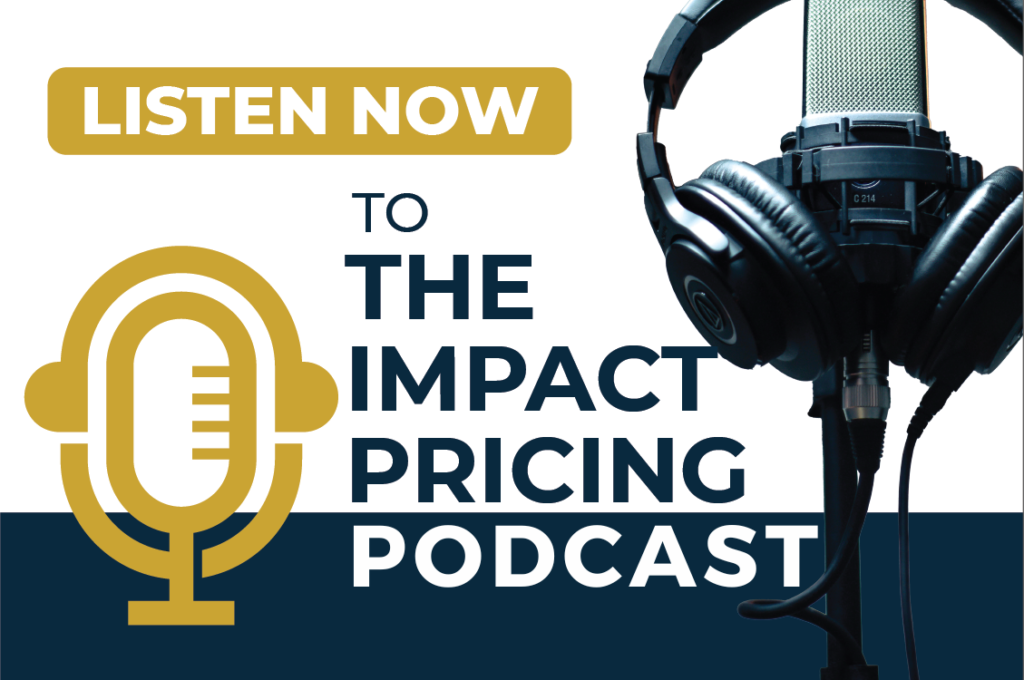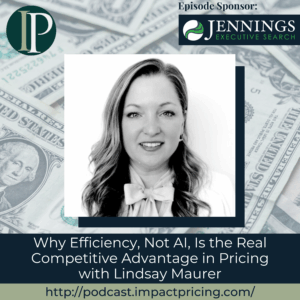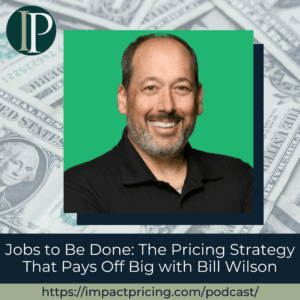Join Mark Stiving for a unique dual-guest conversation with Jon Jennings, longtime Impact Pricing sponsor and successful pricing recruiter, and Ryan Walter, a pricing veteran with over 15 years of leadership experience who recently transitioned into recruiting. Together, they reveal the insider’s view of private equity pricing transformations, from deal diligence to exit strategies.
In this episode, they explore why private equity firms are investing heavily in pricing capabilities, how to determine the right level of pricing leadership for different situations, and the evolving landscape of pricing careers.
The conversation covers everything from pre-acquisition planning to AI’s impact on pricing roles, offering valuable insights for both pricing professionals and business leaders.
Podcast: Play in new window | Download
Why you have to check out today’s podcast:
- Learn the critical difference between hiring a pricing person and orchestrating a pricing transformation.
- Understand the decision framework for determining whether you need a manager, director, or VP-level pricing leader.
- Explore why portfolio companies often resist pricing initiatives and how to overcome that resistance.
“In the private equity space, part of the diligence is we think there’s an opportunity of pricing improvement of some dollar amount to go get. In order to get that, you’re going to need to transform the way things are working, which is building out a team.”
– Ryan Walter
Topics Covered:
02:05 – Ryan’s journey into pricing: From MBA analytics to solving 7-Eleven’s cigarette pricing crisis in Florida
03:29 – Pricing transformation strategies: Why PE’s 5-year timeline perfectly aligns with pricing capability building
07:49 – Pricing as a center of excellence: The evolution from analyst roles to VP-level positions and what’s next
11:05 – Private equity hiring differences: Stakeholder dynamics, investment thesis pressure, and the “shorter leash” reality
14:30 – Pricing problems in portfolio companies: When port cos don’t see the problem PE firms see and how to bridge that gap
17:37 – Pricing transformation explained: Why it’s all-encompassing and requires strategy, finance, data, and leadership skills
20:48 – Transformational roles in organizations: The difference between backfilling and building, and why transformation always wins
23:41 – Hiring pricing professionals for PE: Building pricing advisor roles at the firm level and sharing resources across portcos
26:17 – AI’s impact on pricing: Data foundation requirements and immediate use cases like rebate design and negotiation prep
29:13 – AI in pricing strategies: Competitive data matching, SKU comparison, and the 80% solution approach
32:06 – Promoting the pricing field: Building the next generation of talent and educating people into pricing careers
Key Takeaways:
“In the private equity space, part of the diligence is we think there’s an opportunity of pricing improvement of some dollar amount to go get. In order to get that, you’re going to need to transform the way things are working, which is building out a team.” – Ryan Walter
“The reason I like that word [transformation] is it’s all encompassing because it’s not really one thing. It’s not, oh, we need to get a director of FPA in here. We need to get somebody who understands strategy, who understands finance, who understands data and IT tools, and is a leader that can influence others.” – Ryan Walter
“If you’re going to go for a pricing transformation, you have to dive in with both feet. Halfway doesn’t typically work.” – Jon Jennings
Resources and People Mentioned:
- 7-Eleven: https://www.7-eleven.com/
Connect with Jon Jennings & Ryan Walter:
- LinkedIn: https://www.linkedin.com/in/jonjennings/
- LinkedIn: https://www.linkedin.com/in/ryan-walter3141/
Connect with Mark Stiving:
- LinkedIn: https://www.linkedin.com/in/stiving/
- Email: [email protected]
Full Interview Transcript
(Note: This transcript was created with an AI transcription service. Please forgive any transcription or grammatical errors. We probably sounded better in real life.)
Ryan Walter:
The private equity space, part of the diligence is we think there’s an opportunity of pricing improvement of some dollar amount to go get. In order to go get that, you’re going to need to transform the way things are working, which is building out a team. And the transformation, the reason I like that word is it’s all encompassing.
[Intro / Ad]
Mark Stiving:
Welcome to Impact Pricing, the podcast where we discuss pricing, value, and the entangled relationship between them. I’m Mark Stiving and I run boot camps to help companies get paid more.
Our guests today are, I don’t think I’ve ever done a dual podcast before. We’ve got Jon Jennings, who, as you all know, he’s been a loyal sponsor of ours for several years now. And Ryan Walter, a new person joining Jennings Executive.
Here are three things you want to know about Jon and Ryan before we start. I’ve already told you, Jon’s a long time sponsor of the podcast, a very successful recruiter in the world of pricing.
And Ryan has been in pricing leadership for over 15 years, and he decided to take a step back and become a recruiter. I have no idea why he did that. Welcome, Jon. Welcome, Ryan. How are you?
Ryan Walter:
Doing well, thanks Mark.
Jon Jennings:
Doing well.
Mark Stiving:
Jon, we’ve heard from you before, I got to ask Ryan the ultimate question. How’d you get into pricing in the first place?
Ryan Walter:
I came out of my MBA program, I was doing a concentration in business intelligence and predictive analytics. Landed an internship at 7-Elevens corporate office in their merchandising and operations analytics group, and ended up being a person who our leader felt, he’s got a complex problem that he’s not quite sure what to do with. He could throw me at it and I’d go figure it out.
So, I did a number of different things while I was there. It was really fun. And one of the problems I worked on happened to be a pricing problem where our cigarette pricing had gotten out of line with the market in Florida, and we needed to figure out how to get it back into line with minimal financial impact.
So, lots of complications around that, but that was my first exposure to pricing and I liked it and just ended up sticking with it.
Mark Stiving:
Nice. Every once in a while I hear a guest say, Hey, I worked at so and so. And it’s like, that would be a fun job, right? I think it would be a blast to know how 7-Eleven does pricing. So, just be fascinating. So, if you ever want to come back and talk about 7-Eleven, we can do that.
Ryan Walter:
Okay. Sounds good.
Mark Stiving:
Today we’re going to be talking about private equity and the idea of placing pricing people in and around the whole private equity world. And so, just out of curiosity, Jon, what caused this shift to private equity? I mean, you’ve been doing pricing placement for a long time.
Jon Jennings:
So we started with a large enterprise and the big teams. I enjoy the private equity environments. They’re a little bit smaller. I get to talk to ownership. It’s a little bit more transformational, like the five year cadence that kind of makes sense with the pricing transformation.
If you’re looking to sell something within five years, two years of building capabilities within pricing and then realizing it and doing continuous improvement for three, and then selling makes a lot of sense.
And we’ve gotten a lot of referrals from consulting firms that are in, and others that are in the PE environment. And I get that perspective from the leadership, the ownership, the consulting firm that’s in there, and we can go in and solve a problem and it’s, Hey, we’ve got a transformational roadmap.
This is part of the investment thesis and we’re going to monetize it on the back end. That sounds like a lot of fun versus thinking about a large behemoth company doing a pricing transformation. It’s a lot of fun, but it’s a lot more nuanced with the queue kind of every quarter you’re trying to get to a certain point, and this is a little bit more transactional fun.
Mark Stiving:
Yeah. Do they usually bring you in right at the beginning of an acquisition? Because I can imagine if they wait till year five to make the pricing improvement, they don’t actually get credit for it in the valuation of the sale.
Jon Jennings:
So when they bring us in, so pricing’s identified typically in diligence or kind of ahead of the deal as part of the investment thesis, and then it’s about the roadmap, right?
So sometimes we’re brought in earlier, sometimes we’re brought in mid kind of a year or two in. We’re trying to get in earlier every time as even kind of coming out of that diligence and ahead of the deal to be able to help start to help plan.
Ryan Walter:
Mark, some of that too. I mean, we can absolutely come in and fill a box. But if you get in earlier, we love to be able to help guide and sort of de-risk the transformation by helping the client figure out what the boxes ought to be.
Because depending on how you plan to leverage consultants, how you plan to leverage pricing optimization software, it really impacts the type of team you need to build internally to go forward after. If you’re going to build a lot of capabilities yourself and do all of that in-house, you probably need a director of analytics, and a data science team and all of that.
Where, if you’re planning on outsourcing that to a consulting firm and implementing software, you probably need more of a continuous improvement kind of group that can sort of just take the handoff of that and move it forward without building it themselves. So I think that’s what Jon and I are finding is, getting in earlier is a lot better for our clients.
Mark Stiving:
It actually sounds like what you just said should be done pre-acquisition, post diligence, but pre-acquisition so that as we create the game plan for what we’re going to go do once the deal closes, we’ve got a really solid plan in place.
Ryan Walter:
A hundred percent.
Jon Jennings:
Yeah. And, you know, we can come in and kind of evaluate the current talent landscape. See if there’s some people in there that could maybe be a value added of the transformation or sometimes they have someone that’s pretty good and then they’re not getting paid in the market and there’s transactions happening and the risk of losing them.
It’s like, let’s go put our arms around that person, make them feel, and then give them the resources needed here they’re planning out. Give them the resources they need to go execute. So that’s sometimes the case, but either way it’s good for us to be a fly on the wall to be able to help.
Ryan Walter:
Another thing we do just as a complimentary service for clients is to do an annual talent assessment. It’s something that I would’ve loved when I was back in industry leading pricing teams because sometimes you’ve got a rockstar senior analyst or manager in place that you’re super happy with, and they’ve been in role for three years and they’ve gotten merit increases, but the pricing market has just moved up a lot quicker than the rest of the market has.
We’re sitting on all this data with real time deals that have closed, and we know where comp is to be able to come in and say, Hey, we think you have a lot of risk with this person based on where the market’s at. So, as a leader, you can find out, oh, I have some risk here before the person lets you know that they got a better offer and they’re making a change.
Mark Stiving:
Yeah, interesting. So, Ryan, you’ve been in this business for forever, as have I, right? This pricing world. And a long time ago, most companies didn’t really focus on pricing. In the last five to 10 years, it’s become a much more important topic, but it seems to me interesting that private equity firms are still finding companies to acquire where they don’t focus on pricing.
Ryan Walter:
It’s funny, when I started in pricing, I think there were starting to be a lot of senior analyst roles and there weren’t very many manager roles. Then I moved into a manager role. There were starting to be a lot of manager roles. There weren’t that many director roles.
I think we’re at a place now where pricing is seen as this center of excellence to drive profit. It’s hard to do because it’s cross-functional and all the reasons that everybody who’s out there doing this knows. But we’re getting to a place now where that VP level talent is trying to figure out what’s next.
That’s partly how I ended up in recruiting, it was really interesting, what’s next. That said, out in the real world, there’s a lot of talk about AI. But just getting your basic data foundation in a decent spot so you can start to do pricing work, I still think there’s a ton of that opportunity out there.
Mark Stiving:
Yeah. I hope I remember to ask you about AI later because I really love asking everybody how are they using AI? What does it mean? But when you walk into a new acquisition, how can you tell if they need a pricing manager, a pricing director, or a VP of pricing? What are the cues?
Jon Jennings:
Yeah, I mean, it depends on, so you have to look at the market they’re in, the size, ask them how they’re currently pricing, and how they’re thinking about it. Sometimes it’s, we’re doing, this is how we priced in the past. We don’t really know our cost to serve, so we’re pricing on a cost-plus model without the cost.
So a lot of times we have conversations, the maturity’s not even close to there. So it depends on how they answer these basic questions on the front end of how they’re thinking about it. Start to evaluate, okay, well, where’s the opportunity? Some of these businesses, there’s less opportunity for price transformation than others, depending on the industry they’re in.
But if it’s an industry ripe for transformation, we’ve seen it before. Now, there’s a big difference between software and then like high skew distribution and how you build your teams. But we’ve got kind of notes on FTEs for, okay, we need a leadership person, strategy, analytics, execution, governance, and how many people are going to be cross-functional in those or in each one.
So, I think, if you’re going to do some sort of pricing transformation, you usually need some sort of leader, right? So that’s where it starts. Whether it’s a director or VP, some businesses built the capability, so you need someone to sustain it.
So that’s when you can go down and hire someone a little bit more junior that you can train up. Then have either someone, a third party, or someone internally that knows pricing to be able to make sure to keep an eye on things. But I hate to say, it depends. But each company, depending on their size, it’s going to vary quite a bit.
Mark Stiving:
How do you differentiate between needing a director and a VP? Is it the ability to influence people inside the company?
Jon Jennings:
Exactly, right? It depends on the org structure of the company we’re going into. Some org structure, director’s, really senior, and others you need to be VP. So, who you need to influence across the organization. Just like you said, if you’re a director having to punch up across the entire organization and influence VPs, that’s a little bit more challenging.
And so, that’s where we want to put them on the level footing. So oftentimes, we’ll get to the end and that’ll be a negotiating point of, I’m not trying to gouge you for more salary, but sure, it would make my job a lot easier if I could have the same title of the people I’m trying to influence.
Mark Stiving:
Yep. Is there a difference between hiring someone for a PE firm, a portfolio company versus a standalone enterprise company?
Jon Jennings:
Yes. So, your stakeholders are different, right? So with private equity, you got the ownership and you got the leadership on the ground, right? So, how involved is the PE in the port co is a question, because a lot of times they’ll put out the breadcrumbs and then, if you don’t quite go down that road and you deviate, you have a little bit shorter leash.
Whereas, with other entities where they standalone, or in a PE-backed environment, that’s a little bit more hands off. They can navigate that transformation with a little bit more ability to go down different paths or willingness to. So that’s the, I would say, the biggest difference.
And a lot of times in a PE environment, even if it’s more hands off, there’s the, Hey, we have an investment thesis, pricing’s part of it, we need to do this. Whereas, other entities that we work with, we’re educating them and then bringing authority with consultants or with Ryan and me to say, here’s some opportunity to get a price lift and here’s the people you should talk to.
So, I think it’s just a little bit of a different conversation. And it’s nice to have sometimes a PE partner to massage all the different stakeholders on, Hey, there’s a big opportunity here. And they got that operating partner, pricing advisor, whoever is coming down and really planting the seeds of the idea and it’s coming from the board versus, in other cases it’s coming from a consulting firm that said something, or us, or the CFO ideation that’s going up north. It’s like bottom up or top down.
Ryan Walter:
Mark, I’d also say, PE gets lumped into one big thing, but I’d say different firms have really different approaches to how they interact with their port cos. They also have different strategies as to what they’re trying to accomplish.
Some PE firms, their strategy is, we want to acquire a company that we’ve assessed as being fairly broken with their internal processes and tools. And we have operating partners who specialize in each of these different areas, and we have our playbook. So we purposely brought it because it was broken and we have a playbook in order to fix it up and make it better. And that’s how they’re going to add value to resell it.
Some PE has a roll up strategy where they’re looking for a super fragmented market where they can get a bunch of synergies by buying a bunch of small businesses and grouping them together into a group and then selling off that group. So I think it’s a mistake to think of private equity as one big thing because each firm has its own approach to how they do things.
One big difference, having worked in both private equity backed and publicly traded companies is just the pace at which things happen. And some of that has to do with the size of the companies too. The publicly traded companies tend to be bigger. But I think that’s something as we think about talent, like in a private equity backed firm, they have an exit date and they need you to put points on the board at a fast pace.
I don’t want to downplay the importance of driving results and performance in a publicly traded company because it’s expected there as well. But the pressure of quarterly earnings versus the pressure I’ve experienced from private equity heading for an exit are different, and take different personality types and different types of leadership.
Mark Stiving:
Yeah. One of the things I’ve experienced when I start working with a private equity portfolio company is the port co doesn’t think they have a pricing problem as much as the PE firm thinks they have a pricing problem. Have you guys run into that and how do you handle it when you’re trying to place somebody?
Jon Jennings:
So, I’ll fill that one. Yes, we’ve run into that and that is common. It’s an evolution. It’s like the first conversation, it’s like, well, we got this pricing thing and we’re told to do this and we’re going through the motions. And this is on us to show them, right? We start talking to them about what’s going on and then we bring in the right talent to then garner that conversation.
We build the materials on where the opportunity is, and we partner with a third party consulting firm that came in, and the PE, and the port co leadership. And they start to see, it’s like, okay, this is interesting. And then they talk to really smart people.
Sometimes they’ll do two batches or one segment of the batch is more junior, within the budget that they envisioned. And the other is more of like, Hey, this is maybe what can really drive some change. And the difference in those conversations sometimes can be palpable where they’re like, okay, they start to see it.
And they hear the stories of what they’ve done at other organizations and they see where they’re at in the journey, and they start to benchmark it. And then, the conversation keeps evolving. And the whole time the PEs massaging it in a little bit. We’re talking about telling stories of the impact these people have made on different businesses and how many bips they’ve been able to increase in price and similar types of organizations.
And they start to get more and more curious. They’re probably listening to maybe this podcast or they’re getting on ChatGPT and pricing transformation, they’re doing all their research and so it’s usually an evolution. Most of the time we’ll land where we want to as far as getting the buy-in there to be able to invest in the right person, because sometimes the difference is glaring.
And I tell people, if you’re going to go for a pricing transformation, you got to dive in with both feet. Halfway doesn’t typically work. So we’ve come into a lot of companies where they say, Hey, we’re looking to do this. And we say, okay, well, this is what you need to pay as our fee. This is what’s going to look like.
And then they get, oh, well. They’re like, okay, we’re going to promote someone internally. That’s really smart. And they may or may not be great, but that’s not set up to succeed because they haven’t done it before. And then they call us back, this happened once.
And then they went and hired someone on their own, and that didn’t work out because they went to junior again. They went middle. So they went low, middle, and they called me a third time and then we filled it and it seems to be going pretty well. But sometimes it’s an evolution of, hey, try and fail. Or just through the process of the recruitment like we can make them, you help them see the light there.
Mark Stiving:
I’ve bought bad quality stuff too because I was too cheap, so.
Jon Jennings:
I mean.
Ryan Walter:
I always hesitate to make car analogies with brands because I inevitably offend somebody, so I’m not going to throw out any brand names. But it’s different levels of cars at different price points that will get you different performance, and sometimes the performance matters more than in others.
In some cases, knowing that there’s a range out there. I think, being able to show our clients, Hey, there is a range here, what do you think is the best fit for what you’re trying to accomplish, can be value-add and helpful.
Mark Stiving:
So, one of the things I’ve noticed as we’ve had these conversations is you constantly use the phrase pricing transformation. And I actually love that. And it’s very different from needing to hire a pricing person. So, Ryan, take a shot. Tell me why you say that, what’s the difference?
Ryan Walter:
So, I mean, pricing transformation is when you’re at a place that’s not very evolved and you need to very quickly get to a place where you’re delivering. I mean, in the private equity space, part of the diligence is we think there’s an opportunity of pricing improvement of some dollar amount to go get.
In order to go get that, you’re going to need to transform the way things are working, which is building out a team. And the transformation, the reason I like that word is it’s all encompassing. Because it’s not really one thing. It’s not, oh, we need to get a director of FPA in here. We need to get somebody who understands strategy, who understands finance, who understands data and IT tools, and is a leader that can influence others.
Because being able to do the cross-functional part of getting your head of sales on board in a B2B organization is a huge deal. So I think using the word, nobody says we’re going to do an FPA transformation. Or maybe they do, and I haven’t been around when it’s happened. But I think transformation fits pricing because what needs to be done in order to really move the needle is so all encompassing.
Mark Stiving:
And what I love about that though is that you’re not going to hire someone and get the change, right? What it’s really going to take is someone that says, here’s what it takes to do this change. It takes a real effort, a real transformation, and you guys are essentially saying that up front. So, out of curiosity, do you place pricing people or do you just do pricing transformations?
Jon Jennings:
What’s the difference? So there’s always a transformation to be had, right? I mean, is anyone a 10 out 10 in their org? I mean, I’m sure, I guess we could find whatever the most advanced, mature organization. But usually when you’re hiring a pricing leader, some sort of change in directive.
I mean, sometimes you’re backfilling something that’s already been built, and we absolutely do that. But what I’m trying to find is the area to improve, there’s got to be one piece. It’s like, okay, well now it’s a transformational role because we’ve got this area of, from a deal desk overrides percentage or I don’t know, something that we can come in and they need to go and fix.
So that’s our angle to writing these positions up. So we call them transformational roles. FPA, we also work. Sometimes it’s these big transformations, but a lot of times it’s filling the box and someone that’s got a little bit of a strategy. They can come in and give better advice to the company over, from a financial planning perspective and build out some more KPIs and drive change, where pricing I think is typically more immature than finance and these companies.
So transformation just fits, and that’s always what we’re doing. I mean, sometimes it’s to backfill someone pretty good, but typically it’s taking something that really hasn’t been built before, at least to the level we’re talking about and going and building it. So we always use that word.
Mark Stiving:
I would also guess that if I were trying to backfill someone, your services are less valuable to me than if I’m trying to build a transformation because you guys actually have done this so many times. You know what it takes, you’ve seen it. And so, the guidance on providing a transformation seems much bigger than the guidance in hiring a pricing person.
Jon Jennings:
Yeah, I think our services should yield a big ROI on both. But I would say, yeah, the ROI is much higher on the transformation side.
But you can mess up something that’s already built pretty quickly and in a hurry in pricing with the wrong individual that’s going to come in, especially, because you have to put a big emphasis on culture because you start really ticking off the VP of sales and things can go off the rails in a hurry.
And especially with, in today’s environment, it seems like, especially, in the United States, there’s more volatility, right? So you don’t know what’s around the corner as far as a new tariff coming in or rampant inflation. So having the right leadership in place to be able to navigate that is big.
And I think, even those roles where it’s more mature. And also bringing someone in, it’s like, okay, they’ve got all this cool modeling and stuff they’re doing in pricing. Well, how can I help the rest of the organization and that maybe we should change, this is enterprise analytics that may not like pricing anymore, that’s an element.
Let’s upgrade that and bring someone in that can come in and drive change across your org. Obviously there’s some, because it’s like, okay, hey, first 18 months there’s some cool stuff in pricing. And then beyond that, where can they drive change? They can build some sort of model to help even with acquisitions.
Because if you take this side off, what that does to your pricing so you know where to acquire other businesses based on the modeling that they built on the pricing side. So that’s where everything we’re looking at from that standpoint is transformation.
Ryan Walter:
Mark, I’d also say that. Just thinking about it, even if it’s an established pricing team and you’re putting a new leader over that group or a new person into that group.
Businesses I’ve worked at, our internal HR team, our internal recruiting groups were great, but they just don’t get a lot of at bats filling a pricing role, like branch manager role, outside sales role. Like they fill those a lot. I’d say, even the same thing with some of the larger recruiting firms.
So I know when I was on the other side of the table, in industry, and was having recruiters call me about joining a company to fill a pricing role, they just didn’t have a depth of knowledge about what the role was in order to help figure out whether I was the right fit for that role or not. I felt like often I was educating the recruiter about the role they were trying to fill and then letting them know whether I was a good fit for it or not.
Where, in this role, and working with Jon, we have a real depth of knowledge of the space. So, when we’re talking to clients about what their challenges are and what the role is, we get a really good understanding of what it is. Which then allows us to really explain that to candidates and get the right person excited about it.
Mark Stiving:
Yeah. That makes a ton of sense. Okay, I have two more topics I want to cover, and we don’t have that much time left. So, first topic, do you ever work on hiring a pricing person for the private equity firm itself as opposed to for the portfolio company? How’s that different? What does that look like?
Jon Jennings:
Yes. A lot of times we’ll be working with that person down into the portfolio company. Usually this is reserved for the large top 20, top 30, PE organizations. It’s going down. People are more likely to get a pricing advisor where it’s someone that’s worked in consulting, in industry, impressive career, and they come and they’re sprinkling their magic, pricing pixie dust, across all the different port cos.
So, they’re coming in on the front end after post diligence of saying, Hey, let’s help build this roadmap from a pricing transformation standpoint. And that’s where having someone that’s dedicated, that knows that is great. Now, one thing we do to help them, because sometimes these deals are coming through really fast and they get overextended and they can’t spend 40 hours a week at a port co.
So we’ll offer to provide them a fractional person who will be an arm to them in the port co that can help with the RFP and has done a bunch of these if they’re looking to do consulting or whatever it is, as far as bringing a firm or assessing the current situation on the ground.
But, yeah, we’ve seen more and more private equity building out like the advisor capability within pricing. And a lot of times, the bigger ones will hire multiple folks and they help with the transformation, talk to whoever it’s reporting to a lot, and massage the c-suite on what this pricing org could do for the organization as a whole.
And then, as you go down to smaller organizations, that smaller private equities, they can’t afford within each port co to hire a dedicated pricing person. They just don’t have, the lift doesn’t justify the dedicated resource because they’re so much smaller.
You can kind of put someone that’s more of an analyst, have a consultant come across all the smaller port cos and assess where the impact can be. Set something up, educate the different C-suite executives and sales teams and all that and then place more permanent analysts that can work across multiple port cos at the PE level and share that resource across. I’ve seen that model quite a bit be effective as well.
Ryan Walter:
So, as we think about pricing careers evolving and the pricing profession and specialty evolving, that’s another place where more senior folks later in their careers, their next step is to go into one of these larger PE firms as a pricing advisor.
Mark Stiving:
Nice. Nice. Okay, last topic I want to cover, and hopefully we can do this quickly, but probably not. AI. Do I even need to ask a question? What are people using for AI? How are you finding pricing, heck, I’ve been in pricing for forever and I’m struggling to grasp how AI impacts this whole field. And so, how is that influencing or impacting what you guys are doing?
Jon Jennings:
I’ll let Ryan kick us off because he’s got some passionate thoughts about the maturity of organizations and when they can implement like a full on AI.
Ryan Walter:
Yeah, I mean, I think having really solid foundational data that’s clean and of high quality is super important in a business to support AI. And most businesses aren’t there yet. So getting your data at a place where it can really support AI, I think is important. That said, I think there are some areas around the edges where it can be super valuable out of the gate.
Rebate design is a really interesting one. Give it your fundamental template of how your company does rebates and give it your strategy of what you’re trying to accomplish and characteristics of your customer and see what it comes out with for rebates, I think is really interesting.
Another interesting use case for it for negotiation is to have AI pretend it’s your customer, and have it advise them on how to negotiate with you in prep to go and negotiate price with a customer.
So I think when people say AI, like, oh, well, I’m going to put data into it and it’s going to set all my prices for me, I think we are ways from that. But the more you play with it, the more you can probably find some interesting fringe cases around the edges that can add a ton of value without a lot of investment.
Mark Stiving:
Yeah. So, I love the fact that you mentioned direct or specific use cases because that’s valuable. People can use it.
In the world of B2C, we’ve been using AI forever, right? We’ve got Pros and all the pricing systems. And it may not be the LLMs that we have today, but it’s still AI.
In the world of B2B, this is really fascinating right now. So the negotiation use case was really interesting. I was talking to one pricing person who said he crafted two different AIs to negotiate with each other so that he could watch it.
Ryan Walter:
That’s awesome. I hadn’t thought of that.
Mark Stiving:
I thought that was really good. But, in this B2B world, I’m struggling to figure it out, right? Because everybody’s got their own process.
Ryan Walter:
Another interesting use case for it is dealing with competitive data. So, I got this quote from one of my competitors, and matching skews is always hard. What’s my competitor’s SKU description? Is it really exactly the same as my SKU description? How do the numbers match up? Building that bridge table can be a real challenge and a real impediment to using competitor data.
I think using AI to help clean up your data that way and say, here’s two lists of SKUs, match them up with each other the best you can. Give somebody who understands your products really well an 80% of the way starting point to make some tweaks. So I think it can help you with your competitive data matching if you’re doing top shots.
Mark Stiving:
Okay. I want to throw this back into the world of recruiting now. I would guess most pricing people are not experts in AI today. What are the requirements that we’re looking for in pricing people as we start to place them in companies?
Jon Jennings:
That’s a good question. Something we probably need to put more thought into, to be honest, because it is rapid. Just every quarter there’s some new LLM that’s doing something crazy.
I’ve been playing with the 03 on GPT and the way it can triangulate market research based off of all this disparate information and you see the logic that it goes through is pretty, pretty wild. I think the big piece is being able to prompt and ask the right questions.
Getting the data into there, that’s one thing. The other thing is, okay, how do you use it? It’s a backboard, it can be a massive accelerant. So I think something that we probably should start asking is, how have you used it on a day-to-day basis? Some companies are really strict on the usage because of, obviously, proprietary data. It’s not secure.
We’re looking at building something in-house for us here, and we’ve been using it, leveraging a lot on our side. So we’ve got a lot of different interesting ways. We’ve used it and what we probably need to do is start implementing this into our interview cadence of trying to figure out ways, because it’s all about just being creative on how you interact with the tool at the end of the day, to be able to leverage it properly.
I think people that are, you know, I’m a big evangelist of this stuff internally. And I think it’s increased our capacity, a pretty insane amount, and our quality simultaneously. Which is nice.
Ryan Walter:
It’s a force multiplier. If you do it right, I think it takes every person and gives them a team to manage that, you know.
Jon Jennings:
And I tell people like, everything you’re doing on a day-to-day basis, plug it in. If you look at people in their thirties, forties, fifties, it’s like when the iPhone came out. The more senior folks struggled to use it. The kids were like, yeah.
I think today with AI it’s the same thing where just plugging in and asking certain questions where the younger generation’s coming up in college, they’re super users. They’re using it for everything. They don’t live their life without plugging it into AI. Every decision they make, when they’re negotiating, their gas bill, everything is going into this and it’s becoming more of an operating system than anything.
And so, that’s how I think as we’re talking about implementing it, it needs to become your operating system on a day-to-day basis within your job. And Ryan laughs because I’m like, what are you going to do, plug what I said into GPT? I’m like, yeah, absolutely. I want this to be the DNA of our organization.
And I think, as we think about interviewing candidates, it’s something that needs to be at the forefront. But we’re right there on that precipice where it hasn’t been, we’re not getting that demand from the client, but we probably need to tell them it needs to be a demand, right? But that can be said for any part of the organization, in my opinion.
Mark Stiving:
Yeah. So I could see, I love the line of creativity. I would say the step before that is you have to be open to it. And then once you’re open to it, it’s like, well, now how can I just be creative and use it for many different things?
Jon Jennings:
Yeah.
Mark Stiving:
I think that’s cool. Guys, this has been fascinating. I’ve hugely appreciated it, especially the AI conversation at the end because it’s so hard for me. If anybody wants to reach out to you, how do they do that?
Jon Jennings:
Check out our website, jenningsexec.com. Look me up at Jon, J-O-N, no h, Jennings on LinkedIn and Ryan Walter. Hit us up. Whether it’s, I would say from a, Hey, I just want to know if my team’s organized correctly. Am I paying the right people enough money?
Whatever is, we’ll provide all the consulting on the front end. You don’t have to sign up or do anything. We’ll dive in and help you in any way we can with a caveat of, if there’s a need, hit us up and we’ll fill the box. Help you build it and fill it.
And we build teams as well as place leaders. So, we want to know the next generation coming up. We’re also trying to educate people in other areas to get into pricing and we’re constantly trying to promote the field. I think there needs to be, I’m not a manufacturer of talent, but we’re trying to nudge people into the space.
So, feel free to reach out to us or connect with me on LinkedIn. If there’s someone you’d like to be connected with that I know well, just hit me up and we’ll be happy to facilitate it.
Mark Stiving:
Awesome. Thank you guys.
Ryan Walter:
Thanks, Mark.
Mark Stiving:
My pleasure. To our listeners, thank you for your time. If you enjoyed this, would you please leave us a rating and a review? And finally, if you have any questions or comments about this podcast or pricing, feel free to email me, [email protected]. Now, go make an impact.
[Ad / Outro]

















